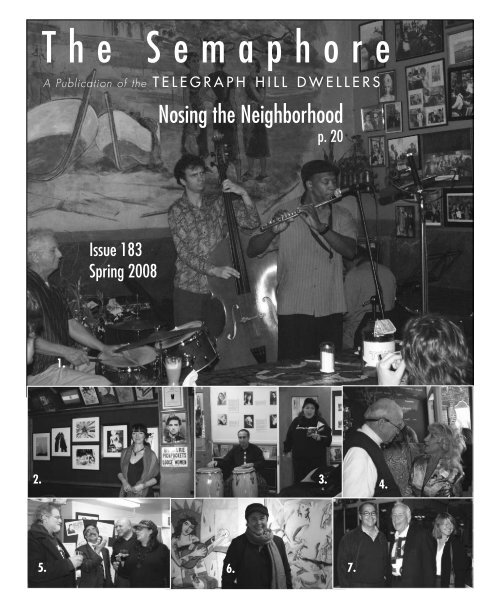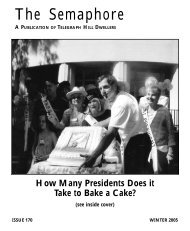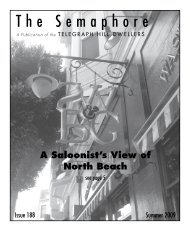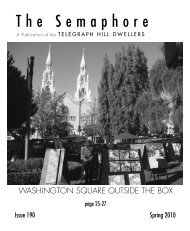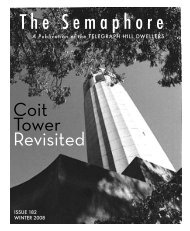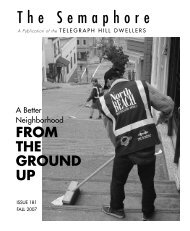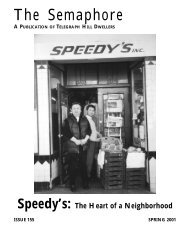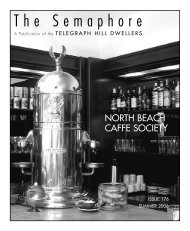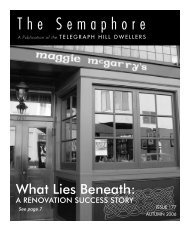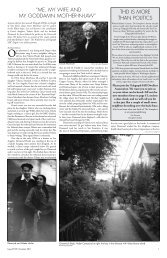Issue 183, Spring 2008 - Telegraph Hill Dwellers
Issue 183, Spring 2008 - Telegraph Hill Dwellers
Issue 183, Spring 2008 - Telegraph Hill Dwellers
- No tags were found...
Create successful ePaper yourself
Turn your PDF publications into a flip-book with our unique Google optimized e-Paper software.
THE PRESIDENT'S CORNERbecame dear friends. With them, we attended PortCommission meetings, Planning Commission hearings,Board of Supervisor meetings, the Dept. ofPark & Rec. meetings. Together we made daily tripsup the Coit Tower stairs and into North Beach. Theyonly live here part of the year. But when they comehere, our frenetic downtown life is happily interrupted.They have a reverence for this place that canonly come from not being here all the time. Theirvery presence reminds us and reminds us again thatnot everyone is so lucky to live here day in and dayout. They single-handedly taught us not to takethis place for granted. They point out the house onUnion that they must see every time they visit orthe gold mansion on top of Chestnut. They visit thesame place on the waterfront where they buy fisheach time they visit. They do great impressions of thebarking sea lions.They have spent countless hours testifying forthe THD at hearings and attending meetings. WhenI became President—they cheered me on, helpedme write speeches, prepared special invitations forsocial events and truly upgraded the quality of ourlife. They listened to all the tales I had to tell andgave me wizened advice; always cautioning to takereasoned, well grounded stands. They told me notto flip out when angry members would send poisonemails. They were right. They said everything wouldbe ok if the Board was unified and not disgruntled.They were right.And so, as my second term comes to a close, myonly wish is that the story of THD and meeting ourneighbors had started much earlier.Thanks to all of you who support THD. It hasbeen a privilege.4 <strong>Issue</strong> #<strong>183</strong> • <strong>Spring</strong> <strong>2008</strong>
OpinionPublic Transit in the Northeast Quadrant:Robust Circulation Worth Preservingby Gerald Cauthen (Transportation Engineer andConsultant; Past President, <strong>Telegraph</strong> <strong>Hill</strong> <strong>Dwellers</strong>)& Howard Wong, AIA (Past Chair, Parking andTransportation Committee, <strong>Telegraph</strong> <strong>Hill</strong> <strong>Dwellers</strong>)NORTH BEACH TRANSIT MEMORIESFor decades, public transportation has coursedthrough North Beach, Chinatown and Russian<strong>Hill</strong>. Those of us who grew up in these neighborhoodsremember quick and easy rides to seeminglyexotic places. For a nominal few coins or a Muni token,new worlds traversed the bus windows of the everpresent15-Kearny, 30-Stockton, 39-Coit, 41-Union.And the faces framed by those bus windows reflectedthe cultural dynamics of the moment. At a time whencar ownership was rare, the robust public transportationnetwork was an integral and defining part ofneighborhood life.SUSTAINED NEIGHBORHOOD VIBRANCYWhen the American Planning Association namedNorth Beach one of the “Top 10 Great Neighborhoodsin America, 2007”, they noted: “North Beach is, inmany ways, a traditional neighborhood. It’s rarely morethan a few blocks walk to find a grocer, bakery, barbershop, hardware store, church, school or park.” They mighthave added that another dimension to North Beach’sintricate tapestry is its access to public transit. It’srarely more than a few blocks walk to busses and cablecars with direct links to urban nodes and transportationcorridors. North Beach has successfully evolvedtowards an urban prototype—including a transportationsystem—which planners and architects areattempting to recreate in other venues.REVERSALS IN PUBLIC TRANSITSo for years, San Francisco’s northeast quadranthas had a healthy transit system amalgamated intothe North Beach landscape where thriving bus stopshave been neighborhood-energizers and social nodes.But recently this system has begun to lose its vigor.Historically, North Beach riders have had multipletransit options to reach BART/Metro at thePowell, Montgomery and Embarcadero Stations, aswell as the Powell St. Cable Car turn-around and theVan Ness Corridor. This flexibility benefited traveltime, linked major transit nodes and short-circuitedjams in the street system. However, these transportationoptions and levels of service have been curtailed.The once reliable and fastest service to Market St./Montgomery Station, the 15-Kearny bus, has beendiscontinued. Its replacement, the 9X/9AX/9BXbus, goes through busy Stockton St. to the Powell St.Station, eliminating the Montgomery Station option.continued on next pagethe Planning andZoning Reportwill return inour next issue.Breakfast& Lunch7 days a week7:30-3:30<strong>Issue</strong> #<strong>183</strong> • <strong>Spring</strong> <strong>2008</strong> 5
Public Transit continued from page 5After a public outcry, the 20 bus was added, linkingColumbus Ave. to the Embarcadero Station—butwith limited hours of weekday service. Previously,the 41-Union bus to the Embarcadero Station hadbeen curbed to weekday commuter hours. And thereare more service cuts looming in the future.PRESSURES ON SAN FRANCISCO’SMUNICIPAL RAILWAYThese changes must be viewed in the context ofMuni’s general health. The system now faces a twoyearbudget deficit of $82 million. Proposition A,passed by voters in November 2007, helped slightlywith a $26 million addition. But these amounts don’taddress the $150 million annual structural deficit necessaryto modernize the Muni system. Transit advocatesand Muni’s Board of Directors rejected a raisein Muni Fast Pass fares—when on-time performancehovered at 69 percent, far below the 85 percent benchmarkmandated by voters in 1999. Furthermore, forthe third consecutive year, Muni ridership decreased,down 5.16% in 2007. One way Muni leaders havechosen to address this depressing situation is by reconfirmingplans to streamline service by shifting resourcesto the busiest lines while reducing or eliminatingunderperforming routes. Unfortunately, recent Muni“streamlining” in the northeast quadrant has reduced,not enhanced, the levels of transit service. And worsemay be on the horizonOne proposed change is a service reduction forthe 39-Coit bus whichunfortunately has onlyabout 390 daily riders.The reduction wouldtruncate the route, eliminatingthe leg up UnionSt. to MontgomerySt.—thus reducingrolling stock and operatingcosts. Union St.,between Kearny andMontgomery Sts., is oneof the longest/ steepestinclines on the <strong>Hill</strong>. In 1954, attempts to drasticallycut 39-Coit service led to the creation of <strong>Telegraph</strong><strong>Hill</strong> <strong>Dwellers</strong> (THD). So, as in past battles, theTHD Parking/ Transportation Committee, transitexperts and residents have begun to brainstorm routeenhancements and funding strategies that would fortifya regional 39-Coit loop. (See page 13)THE CENTRAL SUBWAY AND MUNIOPERATING BUDGETSOther Muni ideas will better serve the neighborhood.The agency proposes increased service onthe Stockton corridor, with the 9/9X and 30-busesrunning every 5-10 minutes during the day. Thisis a smart reallocation of existing Muni budgets,maximizing transportation benefits for the entirenortheast quadrant. This insightful approach needs6 <strong>Issue</strong> #<strong>183</strong> • <strong>Spring</strong> <strong>2008</strong>
Public Transit continued from page 6to be applied to the future Central Subway, with its$1.2 billion budget. The money to improve publictransit systems doesn’t come easy. It is critical thatthe limited amounts of transit improvement dollarsare spent wisely, because they are investments formany centuries and future generations.As final design plans are generated betweennow and 2011, this is the time to maximize $1.2 billionof transportation benefits for the entire northeastquadrant. Currently, the Subway travels only1.7 miles from Fourth/ King Sts. to its final stopat Stockton/ Washington Sts.—arguably the mostexpensive transit project per mile in history. Thenew system provides few benefits for riders north ofWashington St.Observed travel patterns over decades show thatthe densest passenger volumes occur between thenortheastern neighborhoods and Market St. Thedistance between the Central Subway’s ChinatownStation (Washington St.) and Market St. is about½ mile. And the Chinatown Station is five storiesbelow grade. Moreover, the Central Subway doesn’tconnect to Market St—but rather to a new UnionSquare Station, seven stories below grade and 300yards from the existing Powell St. BART/MetroStation. To save money, SFMTA reduced stationlengths to two-cars long, thereby curtailing the abilityto carry more passengers in case the line is everextended northward.We believe that vast majority of residents in thenortheast quadrant, including Chinatown, will continueto rely on the current bus, cable car and F-Lines.The Central Subway won’t even begin to ease trafficcongestion on Stockton and Fourth Streets. Muniwould be saddled with costs of both heavy surfacetransportation and the very expensive undergroundsubway. Quietly, within the Central Subway’s DraftSEIS/SEIR Report, there are forebodings of servicecuts to offset new operating/maintenance costs. Inthe Executive Summary’s Table S-2, page S-12, thefollowing is a synopsis:AlternativeNo Project/TSM(2030)Fourth/StocktonAlignment Option B(2030)Total Annual Diesel/trolley Bus Hours(Systemwide)2,622,0302,545,630The Central Subway would lead to a reduction ofbus/ trolley service, 76,400 hours a year (2,622,030minus 2,545,630 hours). Since the Central Subwayserves the Stockton corridor, likely service cutswould affect the northeast quadrant—-just as theT-Line eliminated the 15-Kearny bus.EFFECTIVE USE OF LIMITED MUNIRESOURCESThe costs of the Deep Subway scheme may escalate,with increasing unknowns about deep boringunder BART and underground streams. Necessitymay dictate the evaluation of options:• DEEP SUBWAY: The current scheme has fewbenefits to northeastern neighborhoods.• SHALLOW SUBWAY: Closer to grade, theCentral Subway ties directly with the Powell St.Station—eliminating the Union Square Station.• SHALLOW SUBWAY, EXTENDED FORBUSES: Tunnels are shared with buses/trolleys,bypassing congested streets—such as in Seattle.• SURFACE FOURTH STREET TRANSITMEDIAN: Subway cars stay on Fourth St./surface, crossing Market St. before entering atunnel—eliminating the Union Square Station.• NORTH BEACH STATION: Cost savingsextend the Subway northward.continued on page 8<strong>Issue</strong> #<strong>183</strong> • <strong>Spring</strong> <strong>2008</strong> 7
<strong>Issue</strong> #<strong>183</strong> • <strong>Spring</strong> <strong>2008</strong> 9
12 <strong>Issue</strong> #<strong>183</strong> • <strong>Spring</strong> <strong>2008</strong>
Jack Early Needs a Gate KeeperBy Herb KosovitizIn 1962 Jack Early obtained a permit from DPWto landscape and maintain a portion of the stubend of Pfeiffer Street, East of Grant Ave. Earlyhad lived on the north slope of <strong>Telegraph</strong> <strong>Hill</strong>—alocation he referred to as “Alcatraz Heights”—sincethe 1950s. He had had an interest in trees and plantsdating back to his Sacramento childhood when hisfather had built him a greenhouse. Over the yearshe planted and maintained some 20 trees on PfeifferStreet, but he always had an eye on beautifyingthe strip of city owned hillsideat the top of his block. TheDepartment of Public Workswasn’t much interested. Toosteep and rocky for beautification,the department said. SoEarly signed a waiver absolvingthe city of financial responsibilityand undertook the projecton his own. He planted shrubsand trees, including a eucalyptusand a Monterey pine. For years,he hauled buckets of water upthe hill to feed the trees.In the 1980s, Cal Rossiobtained a Conditional UsePermit to build the condominiumproject at the Northeastand Southeast corners ofGrant and Francisco, whichabuts that Pfeiffer stub. Due to the efforts of THD,led by Early, a condition of that permit was thatthe Condominium Association develop and maintainthat uphill slope as a public park. Rossi providedold railroad ties for steps and the residentialdevelopment, now known as the <strong>Telegraph</strong> TerraceCondominium Owners’ Association (TTCOA) wascompleted. The landscaped stairway leading to aviewing platform at the top, was named for JackEarly, and opened in June, 1987.In May 1999, a revocable Agreement wassigned between THD and TTCOA, whereby THDassumed the responsibility of locking the gate at thePark entrance between sunset and sunrise, whichbrings us to our present dilemma. The saga of thelocking and opening of the gate, between 1987 andrecent times is not entirely understood, at least notby me. TTCOA seems to have assumed that responsibilityat one time; however, inrecent times they have not hadpersonnel available to do thaton weekends. A member ofTHD who lived nearby keptit open Saturdays and Sundaysfor awhile, but for some timenow it has been locked onweekends.Obviously, it’s importantto have this little gem of a parkopen to the public on weekends,but who’s to do it? Allefforts so far to find a willinggatekeeper are to no avail. Itwas suggested at a recent meetingof the THD Board that thegeneral membership should beadvised of this situation; thatperhaps some good ideas wouldsurface. Finding a willing THD member would bedesirable, however, that arrangement would alwaysbe temporary—people travel, move on, etc. Perhapsa person, or a security organization, could be paid toperform the service. Please email any helpful ideas toHerb Kosovitz at hkosovitz@sbcglobal.net.14 <strong>Issue</strong> #<strong>183</strong> • <strong>Spring</strong> <strong>2008</strong>
North Beach Citizens Profile: Colleen and MichaelBy Brady McCartneyIt all started two and a half years ago. NorthBeach resident Colleen Yerge was walking fromher apartment on Water Street to the TraderJoe’s at Mason and Bay. On her way she passed agentleman camped in front of San Jose Taqueria atFrancisco and Mason. Not wanting to simply walkpast him, Colleen asked the gentleman if he was everhungry. He said yes, of course.Michael Richardson, known to some in the communityas Raven, had been homeless off and on for17 years when Colleen introduced herself to him.Enamored by San Francisco and its music scene, Michaelhad moved to the city as a young man to pursue hisdream of becoming a professionalguitar player. He had worked as alandscaper and later on as a publicschool janitor until he was let go fordrinking a beer on school grounds atthe end of his work day.After his dismissal, Michaelhad trouble finding work and endedup applying for General Assistance(GA) as a stopgap. With a diminishedincome, Michael was forced to move to the RoseHotel on 6 th Street, one of the few hotels he couldafford on GA alone. He lived there until the managementdecided to buy out its tenants, remodel the hotel,and raise the rent. With no option to stay at the Rose,Michael accepted the buyout and moved to anotherhotel where he lived until his GA benefits were discontinuedafter missing one meeting with his GA worker.With no income, no support network, and, consequently,no housing, he became homeless. Michael had beenhomeless in San Francisco for approximately 14 yearswhen Colleen introduced herself.After their introduction, Colleen began visitingMichael every time she shopped at Trader Joe’s. Thetwo would generally only talk for 5 or 10 minutes,but she made a point of seeking him out and Michaelquickly recognized this. Recalling one of her first visitswith Michael, Colleen said, “The first time I calledhim by his name he couldn’t believe someone rememberedhis name.” The more and more the two talkedthe more Colleen wanted to do whatever she couldto help Michael get off the streets, “It was somethingabout his eyes…I couldn’t just keep passing him by.”December 25th, 2007, Colleen was on her wayto volunteer at Marc Bruno’s Christmas Dinner atSaints Peter & Paul Church. On her way Colleeninvited Michael to the event. Unfortunately, Michaelsaid that he couldn’t attend, though he would like to,because he couldn’t leave his belongings unattended.Soon after, Colleen offered tostore some of Michael’s belongingsand, before she knew it, shewas in a little bit over her headand wasn’t quite sure what to donext. Fortunately, Colleen had beendonating clothing to North BeachCitizens (NBC) for the past coupleof years and in her time of needcontacted NBC.Within a matter of days, Colleen introducedKristie Fairchild and Brady McCartney of NBCto Michael and the four of them discussed theoptions available to a chronically homeless man anddevised an action plan for Michael. Two weeks afterbeing contacted by Colleen, NBC had advocatedfor Michael with its various community partnersand executed every part of Michael’s action plan.February 5 th , <strong>2008</strong>, Michael moved into temporaryhousing and is currently taking the requisite steps tomove into permanent supportive housing.North Beach Citizens.www.northbeachcitizens.org. 415.772.0918720 Columbus Avenue,San Francisco, California 94133<strong>Issue</strong> #<strong>183</strong> • <strong>Spring</strong> <strong>2008</strong> 1 5
PARKS & TREES REPORTby Robert MatteiTHD has partnered with Friends of the Forest(FUF) to make it possible for landlords, rentersand homeowners in North Beach and <strong>Telegraph</strong><strong>Hill</strong> to plant trees outside of their buildings and homes.To begin the process of planting a tree, a propertyowner must sign the FUF Letter of Agreement and theDepartment of Public Works (DPW) Tree PlantingApplication Form and submit both forms to RobertMattei, the Chair of the Parks and Trees Committee forthe <strong>Telegraph</strong> <strong>Hill</strong> <strong>Dwellers</strong> and neighborhood representativefor FUF.The FUF Letter of Agreementand DPW Tree Planting ApplicationForm can be found at www.fuf.net/tree_plantings Theweb site also contains information on the benefits andrequirements for planting trees and the many differentspecies to choose from. For those who apply for a tree,FUF will incur the expenses and costs of permit processing,administrative expenses, underground utilityidentification, concrete cutting and removal, orderingof the trees and supplies and coordination of volunteersand planting logistics. FUF will also recommend thespecies of trees that will do well in the North Beacharea. The only cost a landlord or owner will pay is $165per tree during the mass planting, or if it is a replacementtree (one where there is already a sidewalk cut).This fee covers $45 for an 18 month arborist visit tocheck on the health of the tree and $120 in expenses notcurrently covered by government funding.We need to gather 30 applications in order toschedule a neighborhood tree planting, however Iam only halfway there. Janis Kaempfe a long timeneighborhood resident who has assisted me in composingthis article has also been working with me tofacilitate this process. We really need to gather moretree applications to make this happen. Please feelfree to contact Janis at kjanis@mail.com she is helpingme distribute and collect tree applications so wecan make this planting a reality.16 <strong>Issue</strong> #<strong>183</strong> • <strong>Spring</strong> <strong>2008</strong>
BEADS, GLORIOUS BEADS!The Latest from THD’s Oral History ProjectBy Rozell Overmire, Oral History ChairHave you ever entered a store and beendazzled by its merchandise? Yone beadstore has been dazzling its customers fornearly fifty years.On Union Street just above Grant Avenue,Yonemitsu Arashiro (Yone to us) and Hermon Bakeropened a bead store in the 1960’s. Yone collectedbeads for the designer dresses he was producing.He had started the store, Sueko, at the present Yonelocation, with his sister Sue who modeled his fashioncreations.Beads fascinated Yone. He discovered PekingGlass beads in Chinatown, and soon more and morebeads poured in as Yone searched for them in LosAngeles and New York. People were bringing theirbeads to the store, and the Beats and then the Hippieswere buying them. To this day creative souls interestedin jewelry making and fashion, choose special treasuresfrom Yone and Hermon’s collections to sparktheir imaginations.Today, at 85, Hermon has outlived Yone, but heis still dispensing beads to avid customers and hasYone, 1963.Ph o t o by Im o g e n Cu n n i n g h a m, Im o g e n Cu n n i g n h a m Fo u n d at i o n.a new website, yonebee.com, where customers canbrowse online.Our Oral History Committee has interviewedHermon, and the transcript of this interview is availableat the North Beach Library and the San FranciscoMain Library History Room. Take the time to readHermon’s story and then visit his store. As well asbeads, he has more stories to tell you than you willhave time to listen to. Ask the librarians for the THDoral history transcript of Hermon Baker (or any ofthe other 16 oral histories we have produced), and youwill see the neighborhood through new eyes.<strong>Issue</strong> #<strong>183</strong> • <strong>Spring</strong> <strong>2008</strong> 1 7
TEL-HI: Staying Modern for 118 YearsBy Art PetersonThree years ago, <strong>Telegraph</strong> NeighborhoodCenter (Tel-Hi) stepped away from themedical component that had been part ofits full service community effort for 115 years. Therewere some practical reasons for this move—thedoctor who had been providing these services wasleaving, and, of course, medical costs had gone outof control. But according to Tim Daniels, ExecutiveDirector of Tel-Hi, there were other reasons. “Wewanted to move fromthe medical modelwhich has been partof our focus from thebeginning to preventativeprograms.”So Tel-Hi hasbeen developing waysto help its clients, whorange in age from 2½ to 98, to stay well.Says Daniels, “We’veredone our snacks andour lunch menus withnutrition in mind. Wehave a blood pressurescreening programfor our seniors. Twoinstructors from the San Francisco Bay Club cometwo days a week to offer classes on healthy aging,balance and cognition. All this is free.”And in further recognition of clients needs in a21 century environment, Tel Hi has converted whatwas a medical examination room into a computercenter hosting 18 state-of-the-art computers. Thecomputers are put to good use in the center’s afterschool program, but are also used by seniors whoare introduced to computer basics such as setting upemail accounts, communicating with loved ones faraway, and researching topics that interest them.The center is renovating its garden space intoan “environmental garden” that will grow vegetables,herbs, and flowers and will be designed so that theyoungest clients and the oldest—who don’t have asmuch flexibility as they used to— help with both theplanting and the harvesting..Keeping abreast of the times is nothing newto Tel- Hi. Since its inception in 1890 the centerhas made a priority of providing what members ofthe community mostneed. Founded in thatyear by two GraceCathedral SundaySchool teachers,Elizabeth Ashe, 21,and Alice Griffith, 24,one a nurse the othera social worker, thecenter was committedfrom the beginningto serving theneeds of the neighborhoodpoor. 118years ago this “settlementhouse”-- as thiskind of facility wascalled at the time--was a new idea. Modeled on Jane Addams HullHouse in Chicago, the center, at its home on VallejoStreet, aimed to provide what Daniels today wouldcall “a one stop shop,” serving the physical, social andeconomic needs of low income families.And in 1890 most <strong>Telegraph</strong> <strong>Hill</strong> residents wereindeed low income. Large families on the westernslope of the hill were jammed into tiny flats withoutplumbing or heat. Children were pulled out of schoolto sell flowers or otherwise support their families.continued on page 2518 <strong>Issue</strong> #<strong>183</strong> • <strong>Spring</strong> <strong>2008</strong>
Restaurant ReviewGERALD HIRIGOYEN:FOUR STARS FOR COMMUNITY SERVICEBy Carol PetersonAfter attending the North Beach Citizensannual fund raiser at Sts. Peter and PaulChurch in North Beach, I decided to changethe focus of this quarter’s review because of theimpression our neighborhood chef and restaurateur,Gerald Hirigoyen, made on me. Gerald’s establishments,Piperade, at 1015 Battery and Bocadillosat 710 Montgomery consistently appear on theChronicle’s Top 100 Bay Area Restaurants list.Because Francis Ford Coppola, the founder ofNorth Beach Citizens who normally takes on kitchenduty for this event, was out of the country filming,Gerald was invited to cook the entire dinner for 450guests, a challenge he accepted with relish. When Iinterviewed Gerald he was also getting ready to preparethe main course for 300 guests at the Taste ofTel-Hi fund raising event held May 10.For our interview we sat at a little corner tableat Piperade. Gerald positioned me where he couldwatch the dining room as I asked him a few questionsabout his charitable contributions to our neighborhood.Carol: How did you decide to become so involved inthe community and the charitable events you do?Gerald: (chuckle) I’ve been around San Francisco for28 years and know so many people. When NorthBeach Citizens asked me to do the dinner I wasvery pleased because it was a challenge for me toprepare that much food. I love to break my ownrecords. Also, the events that I do in North Beachare special to me because they are low key, unlikeother charitable events in the City, where everyoneis trying to outshine each other. I love that I cancontribute to North Beach Citizens and Tel-Hiand know that most of the money is going right tothe cause. It is important to me. I try to do theseevents using the freshest ingredients, with greattexture and taste. If you go in with that attitude,the meal will always be good.Carol: How would you compare preparing for bothof these events? They take place in a relativelyshort time span.Gerald: The difference in the two events is huge. Forthe Citizens event we went in to start the cookingand preparation work four days in advance.A caterer friend of mine helped with storage andovens. Many of my staff and I worked overtime.We prepared the meal the day before to test howeverything tasted. On the day of the event, we hadfour staff people in the kitchen that morning andthen that evening, we had five staff people. We hadfive or six very helpful volunteers in the kitchen, aswell. Because we were serving family style, it wasimportant that the kitchen was very organized.The food had to come out hot, on time and flow.We thought it went very well. The Tel-Hi eventis different because we are only preparing themain dish, so there is much less preparation, eventhough we are serving 300 people. The individualplates will be taken to the tables by a stream ofvolunteer servers. The important part of the individualserving is that the food gets out on time andhot. I haven’t figured out what I am serving thatnight, but I think it will be some kind of braisedmeat. We’ll see.Carol: What do you do about the vegetarians?Gerald: (smile). They will just have to raise theirhands! I have been living in California so long thatcontinued on page 22<strong>Issue</strong> #<strong>183</strong> • <strong>Spring</strong> <strong>2008</strong> 1 9
Artist Agneta Falk at her opening at WormsThe Alfa Nose, <strong>Spring</strong> <strong>2008</strong> SpAlfa Romeo Spiders arevery social. Drop thetop and they effortlesslyfind their way to the nearestlocation of fun. They are cute,even stylish (Italian designer),go with anything-- from thebricks of the Barbary Coast toCoit Tower -- and adventurous.Driving over Green Streetbecomes an “E Ticket” ride!Cruising Grant Avenue is ‘cool’,and pulling up to the fire plugin front of Gino & Carlo drawsa welcoming committee.The ‘77 Spider Veloce “AlfaNose” has been sniffing outnews for the past two years. ItJulia of Knitz and Leathersmodeling one of her handtooled leather jackets a laMarlena DietrichThe SpiderTHDers Sean and Sherry O’Donnell at theirOpening at Worms20 <strong>Issue</strong> #<strong>183</strong> • <strong>Spring</strong> <strong>2008</strong>BJ Poppa aHoliday Pa
ider’s Special Photo Columnhas poked its Pininfarina Noseinto the galaxy of North Beachart galleries and (figuratively)crashed the field of Ferraris onWashington Square, ColumbusDay, all to report on <strong>Telegraph</strong><strong>Hill</strong> news. We, Spider andmyself, are continually in aweof the jewel box that comprises“The Neighborhood,” places,people, events. Something isalways happening. Since Spideris an avid photographer, belowis a ‘column’ of photos. (ActuallyI more often than not walk, butdon’t tell Spider that. He wouldbe crushed (figuratively!).—Kathleen CannonEnrico and Christine Deeb at Enrico’s last interviewFranco ofPorziuncola beforethe replica of St.Francis of AssisiShrineSurvives; The Castle Doesn’tnd Emily Palen entertain at THDrty at Caesar’sCaffe Greco—Auction of Ferlinghetti artwork—Joe Butler, Ferlinghetti,owner Hanna Suleiman and Officer Fred Firth<strong>Issue</strong> #<strong>183</strong> • <strong>Spring</strong> <strong>2008</strong> 2 1
Gerald Hirigoyencontinued from page 15I understand all about Californians and their varieddiets. I always cook enough of everything that Ican put together a vegetarian meal very easily.Carol: How do you figure out how much to spendfor these dinners?Gerald: Because we are a small business, we like towork with people who have a budget. If we havethe budget, we can plan the meal where they getgood food, with fresh and high ingredients. Notthat the budget always covers the cost of theevent, as there are staff people, etc. but that is fine.Staying within the exact budget is not what this isabout. I love to be a part of the community.At this moment, we are interrupted by Geraldmotioning to the waiter to see the three dishes he isbringing to customers he was talking with when Icame in. He approved the dishes and we resumed.Carol: So, are you besieged by people all the time todo these types of events?Gerald: Yes, (shrug and smile) you pick and choosethe ones you want to do. I love the small charitieswhere it all goes back.Carol: And may I ask where you went to school tolearn to become such a wonderful chef?Gerald: I didn’t. go to chef school. I grew up in theFrench Basque area, Biarritz. My parents werenot professional cooks but very good ones andI cooked all my life. When I was 13, I told myparents that I wanted to be a chef and off I went.They were very worried about me because the lifeof a chef is a difficult one. There are long days.You give up all your free time. Holidays are spentwith customers and not your family, etc. But, I lovewhat I do and am very glad I did it. I like to thinkof myself as not only a chef but as a restaurateur,who can handle the front and the back of the restaurant.As you know, there are many things thatgo wrong between the front and back. My goal hasalways been to be a good chef and a good businessowner. Every Wednesday the Food Runner comesby for left over food to deliver to charity. We rarelyhave anything left, so then we will make a littlesomething.And with that after the traditional French kisson both cheeks from Gerald, I said goodbye tothis charming, friendly chef and owner of PiperadeRestaurant.Front cover photo captions1. Cafe Trieste—N. Beach Jazz Festival kicks off the SF International Poetry Festival; 2. Artist TinaTarnoff at her opening at Vesuvio’s; 3. THD Social Director Sarah Kilban recites at THD Beat Omage;4. Dick Boyd and Chi Chi Banducci (Enrico’s niece) at Enrico’s Memorial; 5. Three Cool Cats (TonyLong, Aaron Peskin, Jerry Cimino) and a Hip Chick; 6. Spec’s daughter, Elly Simmons, displaying herartwork at Worms; 7. Greg Chiampou, Art Peterson and Nancy Shanahan at THD Caesar’s Dinner22 <strong>Issue</strong> #<strong>183</strong> • <strong>Spring</strong> <strong>2008</strong>
Win/Win 39 Coit continued from page 13“discriminatory” parking, although there are examplesof selective discriminatory parking all over theSan Francisco metro area. This “politically correct”approach harms everyone affected:It harms visitors, because they are relegated—defacto, because of the “car habit” mentality—into an“interminable” queue of cars during popular times,sometimes stretching to 30-or-so all the way toLombard Street, causing many hopeful visitors toturn around and leave. The irony is that visitors don’tneed their car close at hand to enjoy their Coit Towervisit. An unfettered bus would take them up the hillin seconds and bring them back down.It harms all riders at all stops on the route,because of the unreliable arrival times.It harms the nearby neighbors on <strong>Telegraph</strong><strong>Hill</strong> Boulevard by spewing idling car and bus fumesunder their windows (to say nothing of global warning;how “green” is it to have 10-30 cars idling constantlyon the boulevard all afternoon, for 115 or sodays per year?).It harms the nearby neighbors whose only parkingalternative is the Coit Tower lot, because they haveto wait in the “endless” queue just to drive home.MTA management must recognize that the CoitTower parking lot has a different value to visitors, asopposed to nearby householders. To the visitors, ithas no value because of no need for their cars at theTower. The nearby residents, however, have a legitimateneed to park their cars there, because it is theonly “street” parking they have.In addition to all of the above, MTA managementshould expand the route marginally and capturemany more riders. Members of the <strong>Telegraph</strong><strong>Hill</strong> <strong>Dwellers</strong> have spent countless hours trying tohelp solve this problem. It has worked out a proposedroute modification, which is:• starting at Safeway, the bus would travel to pier39, which is often swarming with potential riders;• then through Fisherman’s Wharf to the lower endof the Lombard crooked street;• then south, passing many people-filled apartmentbuildings and on down east to the twin garages onVallejo, where visitors can park their cars and pickup the bus for a great ride to Coit Tower;• then to Washington Square Park, to Montgomery& Union, and on to Coit Tower;• then back again to Safeway to begin another runfor waiting visitors.continued on page 24PARKING AND TRAFFIC BACK IN BUSINESSGail and Paul Switizer have agreed to act as co-chairs of THD’s reconstituted Parking and TrafficCommittee. Meetings of the committee will be on the first Saturday of each month at 11:00-12:30pm at North Beach Citizens, 720 Columbus. THD members interested in becoming involved on aregular basis and willing to take on assignments should contact the co-chairs at switzer.gail@gmail.com<strong>Issue</strong>s that the committee will be discussing during the next few meetings includeCoit Tower—traffic, parkingBus service modifications for the #39 busValet parking for North BeachLight Rail extension to North Beach and Fisherman’s Wharf,Pedestrian Safety issues at Coumbus/Stockton/Green<strong>Issue</strong> #<strong>183</strong> • <strong>Spring</strong> <strong>2008</strong> 2 3
The Pagoda, a Palace No MoreBy Art PetersonNo building in our neighborhood embodiesmore glorious cultural history and depressingfalse starts than the boarded up structureat 1741 Powell Street, still referred to—withfleeting hope—as the Pagoda Theatre. No theatre—or any other activity—has taken place on this sitesince 1994.That’s not to say there haven’t been lots of tries.Presently, restaurateur Joe Campos who has ownedthe property since 2004, is making a second attemptto open a Mexican Restaurant at the site. His plansalso include plans for 19 market unit condos and 27parking spaces.The Semaphore will have more to say about thisplan in our next issue. For now we want to presentan overview of the celebrated past of this bedraggledstructure.BeginningsUp until the 1906 Earthquake and Fire a RussianCathedral stood on this site. But that catastrophicevent that wiped out most of North Beach demolishedthe Cathedral as well. In the years following1906 a neighborhood that had been multi-ethnicbecame increasingly Italian as Southern Italianspoured into town to join the rebuilding of theneighborhood. Antonietta Pisanelli, a singer turnedimpresario enlisted the help of the notorious politicalboss Abe Ruef to push through a plan for TheWashington Square Theater which specialized in allthings Italian from variety theatre to drama to opera.The renowned Italian tenor Tito Schipi played thislocation in the 1920s.The Milano, then The PalaceBut by 1930s, America had gone movie crazy andlive theater was on the back burner. The WashingtonSquare Theater was reborn as the Milano. Still underthe stewardship of Pisanelli, the Milano showedAmerican films during the day, but featured Italianlanguage films, and sometimes drama in the evening.In the late thirties the theatre had been extensivelyremodeled in the Art Moderne style and reopened asthe Palace in 1937.But in 1941, the U.S. government began confiscatingItalian films, as well as German and Japanesemovies, and the theatre switched to all- Americanfare. June Osterberg, writing in the North Beach Beatremembers this period. “In those days a matineeticket costing 5 or 10 cents would include a newsreel,a cartoon, a serial episode—like Buck Rogers—andboth an “A” picture and a “B” picture. There was amalt shop in the building called Bozo’s that had greatmilk shakes and hot dogs for a nickel.”The Golden Age of the CockettesIn 1967, The Palace, under new owners, startedto show exclusively Chinese movies. Two years later,in 1969 the theater entered its most notorious periodas home to San Francisco’s Cockettes, a performancecontinued on page 28Win/Win 39 Coit continued from page 13It’s time for MTA management to take this quitefeasible action to make 39 Coit richly useful to theresidents. Isn’t that the point of a municipal transportationline?It’s time for the MTA to tell us how it can makethe 39 Coit serve us better—rather than telling uswhy it can’t.24 <strong>Issue</strong> #<strong>183</strong> • <strong>Spring</strong> <strong>2008</strong>
Tel-Hi 118 years old contineud from page 18Whooping cough, typhoid fever and diphtheria were rampant,more so on the <strong>Hill</strong> than anywhere else in the city.To this depressing environment Ashe and Griffith broughtsome relief. They offered a club for boys and classes in sewing and“domestic science” for girls and later a kitchen, garden, gymnasiumand library. Drawing, dancing and singing classes were also offered.The center provided a day nursery, a health clinic and even anoperating room. Tel-Hi launched the first school nurse program onthe west coast.Some years later, when North Beach was destroyed by firefollowing the 1906 earthquake, it was Tel- Hi that ministeredto the needy in the tent city the organization helped set up inWashington Square.A year later Tel-Hi purchased a site at 1736 Stockton St.and commissioned renowned architect Bernard Maybeck to buildthe center a new home, a building that still stands. Then, in 1954Tel-Hi moved to the seemingly quiet location of 660 LombardSt. where the center remains today. Any quiet at Tel-Hi, however,ends at the sidewalk. Inside a staff of 42 (20 full- time and 22 parttime)plus 37 volunteers serve 600 community members each day.Those 600 people represent a more diverse group than the largelyItalian immigrant community the center served in 1890. Today thecenter reaches beyond Telegaph <strong>Hill</strong> and out to polyglot areas ofNorth Beach and Chinatown. So the center must draw regularlyon the many languages its staff speaks. “We currently do not havea staff member who is fluent in Russian,” says Daniels. “So we havebecome dependent upon a volunteer to provide a translation toRussian immigrants we serve in the senior program.”A bit of logistic magic makes it possible for Tel-Hi to serveall these people in a relatively small space. It turns out that whenone group of clients leaves, another group is entering. Each morning140 local seniors arrive for the health and fitness activitiesdescribed above as well as English as a Second Language Classes,Tai Chi, a nutritious hot lunch, and social activities such as games,mask making and line dancing. Daniels says that these activitiesgive these seniors the community they need to stay mentallyhealthy. “Isolation is the biggest disease,” he says.At 2:30, after the seniors leave, the 105 K- 5 th grade studentsarrive for the After School Academy (that also operates full-daycontinued on page 27<strong>Issue</strong> #<strong>183</strong> • <strong>Spring</strong> <strong>2008</strong> 2 5
GINO & CARLOSince 1942At a party on Green Street last December honoringthe late restaurateur and baseball coachDante Benedetti, Soto Mare owner GiGi Fiorucciunveiled this Jasper Alley Mural depicting thosewho had played under Dante’s tutelage.548 Green StreetSan Francisco, CA 94133 (415) 421-0896HELP THE ‘HOODShop Locally26 <strong>Issue</strong> #<strong>183</strong> • <strong>Spring</strong> <strong>2008</strong>
Tel-Hi 118 years old continued from page 25programming in the summer). At the academy, inaddition to receiving tutoring in school subjects,these students enjoy a range of other activities fromcreative writing to sports to organic gardening andcommunity service learning projects.Tel-Hi also offers an Expanded LearningProgram at nearby Francisco Middle School where150 youth in grade 6 through 8 experience afterschool activities such as cooking, biking/bike repair,comedy, and film making, all aimed at fostering enthusiasmfor learning.Back at theLombard Streetsite Te-Hi providesa quality Statelicensedand accreditedyear-round preschool program for42 children betweenthe ages of 2 1/2 and5. Tuition for thismuch in-demandprogram is on a slidingscale based onincome, with 1/3 ofthe students on statesubsidies. Because ofTel-Hi’s Well Baby Clinic.the pre-school’s reputation, it has a rather dauntingwaiting list for admission.Tel Hi has never limited its activites to its fourwalls. Griffith and Ashe lobbied against a proposedplan to make passage across the city easier by flattening<strong>Telegraph</strong> <strong>Hill</strong>. They opposed smoking on streetcars, fought successfully the quarry owners who weredestroying the <strong>Hill</strong>’s eastern slope, and tried to getthe city to reduce density in neighborhood housing.Fast forward and you’ll find Tel-Hi still takingup neighborhood causes. Consider the case ofthe demolished North Beach Place, the subsidizedand low income housing development at Bay andPowell. It was Tel-Hi, along with the <strong>Telegraph</strong> <strong>Hill</strong><strong>Dwellers</strong>, that faced down development interests tochampion what is now a new facility of 342 modernunits dedicated to low and moderate income housing.Many of the former residents of the complex havehad a chance to return. Tel-Hi has set aside places inall its programs for residents of North Beach Place.For example 60 percent of the slots in the center’sYouth Leadership Development Program are filledby young people from the complex. Tel-Hi also runsa teen center onsiteat North BeachPlace. The programoffers 50 teens accessto homework support,tutoring, computers,and enrichmentactivities afterschool and duringthe summer.Mirroring thesettlement housetradition of its roots,Tel-Hi both dependson and serves thelocal Community.The generosity ofneighbors, as illustrated, for instance, by the financialsupport locals provided at the center’s May 10 fundraiser,“A Taste of Tel-Hi,” helps keep the center’sdoors open and the impressive programs alive andgrowing. But Tel-Hi looks for more than donors; itencourages donor/participants. Community membersvolunteer in the various programs, teach classes,organize fundraising events, help in the garden andmore.In turn, the community at large makes use of theTel-Hi facility. THD’s own Planning and ZoningCommittee uses the center’s utility room to meet, ascontinued on page 31<strong>Issue</strong> #<strong>183</strong> • <strong>Spring</strong> <strong>2008</strong> 2 7
The Pagoda continued from page 24group that Douglas Cruickshank described “an outrageoustheatrical troupe comprising gay men, womenand babies who use their LSD-infused exuberance,imaginations and a gift for dressing to the nines inthrift store drag and glitter to illuminate a series offunny, flamboyant and utterly unprecedented midnightmusicals.”One attendee remembers, “As the Chinese moviegoers were leaving at midnight throngs of peoplewould gather waiting for the box office “lady” to finishdecorating the box office window usually withfeather boas so they could buy $2.00 tickets to seethe Cockettes.”The Cockettes performance of a piece like“Tinsel Tarts in a Hot Coma” would be followedby campy movies. Busby Berkeley and Betty Boopcartoons were favorites.The loose scene continued for some years.Remembers one attendee:”At a midnight movie in1971 Bette Milder and Barry Manilow, then performingat Bimbo’s 365 Club, came in. He went tothe piano on the main floor and started playing atune, and she went on stage and yelled ‘anyone haveThe Pagoda Palace Theaterc o u r t e s y Sa n Fr a n c i s c o Hi s t o r y Ro o m, SF Pu b l i c Li b r a ryThe Pagoda Palace Theaterc o u r t e s y Sa n Fr a n c i s c o Hi s t o r y Ro o m, SF Pu b l i c Li b r a rya joint? From the balcony a shower of joints raineddown, and Bette picked most all of them up.”The Palace, then the Pagoda, then thePagoda PalaceIn 1974, in keeping with the Chinese fare featured,the theatre was renamed the Pagoda. Its wilddays were somewhat behind it though one attendeeremembers that “the management was pretty permissiveas long as you were a paying customer. Outsidefood was perfectly acceptable, as was chugging 40ouncers of beer and smoking in the theater.” Duringthese years the theater showcased Hong Kong’s newwave cinema, featuring the work of John Woo andJackie Chan before they became international stars.Briefly in 1986 the Renaissance Rialto theaterchain took over the theater, rechristened it thePalace, refurbished the old building and opened it asa repertory house. According to Osterberg, “The firstmovies featured were two filmed in San Francisco:‘The Maltese Falcon’ and ‘Dark Passage.’ They wereshown at a $10.00-a-person fundraiser to save theGrace Marchant Garden.” But soon the repertoryeffort failed and the theater returned to showingChinese films. Now it was the Pagoda Palace.continued on page 3028 <strong>Issue</strong> #<strong>183</strong> • <strong>Spring</strong> <strong>2008</strong>
A Port Primer: <strong>2008</strong> EditionBy David A. SmolenMy suspicion is that if you’re like me youhave only a tenuous grasp of the piernumbering system in San Francisco, andeven less sense of what is happening in the efforts todevelop/preserve those piers. You know that Pier 39is in the middle of the tee shirt shops of Fisherman’sWharf, visited by hordes of tourists and noisy seals.Likewise, you might be able to identify Pier 23because you vaguely remember stopping in for adrink after a date with someone whose name you nolonger remember. And if your knowledge of the SanFrancisco pier numbering system is on par with mine,you regularly see cruise ships berth near our fair hill,but you can’t really say where, other than you’re fairlycertain they don’t berth at the beer garden on Pier 23or next to the seals on Pier 39.On a quest for knowledge and to satisfy theSemaphore editor’s request for a story updating thedwellers of <strong>Telegraph</strong> <strong>Hill</strong> on the negotiations surroundingPiers 27-31, I set out for answers.First, a little background for the uninitiated.Apologies in advance to the cognoscenti among themembership of THD who are experts in waterfrontissues and know the home phone number of theExecutive Director of the Port Commission.The piers of San Francisco, along with 7.5 milesof City waterfront, are overseen by the San FranciscoPort Commission, which describes itself as “a publicenterprise committed to promoting a balance of maritime,recreational, industrial, transportation, publicaccess and commercial activities on a self-supportingbasis through appropriate management and developmentof the waterfront for the benefit of the public.”A five member Board of Commissioners governs thePort of San Francisco, and each Commissioner isappointed by the Mayor and subject to confirmationby the City’s Board of Supervisors to serve a fouryearterm.The pier numbering system resembles the seatingchart of the War Memorial Opera House, whereMarket Street plays the dividing role of the centralaisle. All piers to the left (or north) of Market Streetas you approach the waterfront are odd-numbered,and all piers to the right (or south) of Market Streetare even numbered.At some point between 1849 and 1970 (roughlythe time it took for leather chaps to take on a significantlydifferent cultural meaning), the amount ofshipping activity in San Francisco drastically declined.Transportation experts calculate that somewherearound April 28 th , 1974, the number of cargo containersentering the Port of San Francisco was surpassedfor the first time by the number of Midwestern familiesin shorts taking afternoon cruises to the GoldenGate Bridge. The trend has continued unabated sincethen, and upkeep of the piers has suffered a correspondingdecline as much of the region’s shippingactivity moved across the bay to the Port of Oakland.At the same time, tourism replaced manufacturingand fern bars as the largest industry in San Francisco,and cruise ships took on an increasingly importantrole within the City’s largest industry.Today it is widely acknowledged that the currentberth for cruise ships in San Francisco – Pier 35 –is crumbling and will not accommodate the cruisebusiness entering San Francisco for much longer. Anew cruise ship terminal has to be built soon, or SanFrancisco risks losing a significant source of tourismrevenue. Complicating matters is the pesky problemthat someone needs to pay for the new terminal.Enter the developers. The general formula forfinancing such projects is that the Port Commissiongrants development rights to a property developer tobuild on Port of San Francisco land. The developermakes a return through the receipt of lease paymentsfrom its tenants. The development project, in turn,continued on page 30<strong>Issue</strong> #<strong>183</strong> • <strong>Spring</strong> <strong>2008</strong> 29
A Port Primer <strong>2008</strong> continued from page 29pays a lease fee to the Port Commission, and thenew development generates tax revenue. The PortCommission uses the lease payments and the estimatedtax receipt increment to issue a bond, whichin turn pays for the development of projects such asthe new cruise ship terminal.And that’s where the fun begins. If only finding areasonable compromise between the scope of waterfrontdevelopment projects and sufficient revenuegeneration for the Port Commission were as easyas finding a fleece for under $10.00 on Fisherman’sWharf.The development of Piers 27-31 has a long andcontroversial history dating back to the turn of thecentury (not the one with the Gold Rush; the oneThe Pagoda continued from page 28In 1994, facing competition from video andbecause of decreased attendance following a gangshooting in the theater, the Pagoda Palace closed forgood.The End of the EndLater that year, Lam Kin Ming a Hong Kongreal estate developer and garment manufacturerbought the building for a purported two million dollars.In preparation for building a shopping center,the new owner gutted the building of its art decoaccoutrements, including its ticket booth and thecurving staircase. A number of design plans weresubmitted in the following years—at least one ofwhich was approved by the neighbors—but no developmentmaterialized.Then in 1997 the infamous Rite-Aid controversyerupted. This was a time that drug stores and bankswere looking for a home on every corner. The drugstore corporation Rite-Aid was particularity interestedin San Francisco. By 1997, they have established 7with Starbucks and Apple Computers). This historyhas been covered through the years by the Semaphore,so I won’t bore you with the details, other than to saythat the previous developer, the Mills Corporation,crashed and burned after strong opposition to itsplans and manners, and it sold its development rightsto the hometown duo of Shorenstein Properties andFarallon Capital Management.The Shorenstein group took over the remainderof Mills’s exclusive right to negotiate (ERN)for Piers 27-31 in early 2006. Sixty plans, 100 proformas, and several extensions of the ERN later, andthe Shorenstein group is on the verge of presentingits latest plans for the piers before the current ERNexpires on May 31, <strong>2008</strong>.continued on page 38SF locations and had plans for twenty more. One ofthese was to be a twenty four hour pharmacy on thesite of the Pagoda. The neighborhood erupted in displeasure.At a community meeting—with the exceptionof neighborhood gadfly Richard Hanlin—therewas universal opposition. The community rented abill board to publicize its message “Rite/Aid/WrongPlace” and Rite Aid gave up its quest for the Pagoda.Although even in the end the company didn’t seemto get it. A Rite Aid spokesperson commented onthe company’s automated prescription dispensingmachines; “Our new state of the art system makes thepharmacy almost like a factory. It’s almost like a conveyerbelt.” Conveyer belts in North Beach? What’swrong with that picture?So Rite Aid went away, but the saga of thePagoda continues. More in our next issue.June Osterberg’s North Beach Beat stories“Theater on the Square” and “When the CockettesPlayed the Palace, “ provided valuable informationfor this piece.30 <strong>Issue</strong> #<strong>183</strong> • <strong>Spring</strong> <strong>2008</strong>
Tel-Hi 118 years old continued from page 27does the District 3 Democratic Club, and many otherneighborhood groups. Daniels notes that the neighborhoodis going to be the center of a lively supervisorialelection this fall. Tel- Hi, he points out would bea great place to hold a debate among the candidates—and plans are already in the works for the Center tohost a “Meet the Candidates” evening in June.Want to know more about Tel-Hi? ContactDonna Faure, Director of Development, 415-421-6443 x 34 or donna@tel-hi.org<strong>Issue</strong> #<strong>183</strong> • <strong>Spring</strong> <strong>2008</strong> 3 1
Fog <strong>Hill</strong> MarketHanna Chedyak415-781-88171300 KearnySan Francisco, CA 9413332 <strong>Issue</strong> #<strong>183</strong> • <strong>Spring</strong> <strong>2008</strong>
<strong>Issue</strong> #<strong>183</strong> • <strong>Spring</strong> <strong>2008</strong> 3 3
Conveniently located in the heart of North Beach, FinancialDistrict & Jackson Square.Sync Salon has been designed with an ergonomic andsustainable concept in order to provide its customers with astress-free and tranquil experience.Our licensed professionals offer state of the art services andproducts for hair, skin, and body.The Sync Salon Team invites you to our sanctuary. As a GrandOpening Promotion, bring in this ad for a 30% discount on Therapeutic,Swedish Massage, Facials, Microdermabrasion and waxing, and HairServices. Offer expires July 31, <strong>2008</strong>.Call 415-397-1078 for your appointment.Sync Salon170 Columbus AvenueSan Francisco, CA 9413334 <strong>Issue</strong> #<strong>183</strong> • <strong>Spring</strong> <strong>2008</strong>
Exp. 4/25/08<strong>Issue</strong> #<strong>183</strong> • <strong>Spring</strong> <strong>2008</strong> 35
FROM THE DESK OFSupervisor PeskinLights OutSometimes the most obvious things are rightunder your nose. I don’t know about you butseeing entire floors of office space with theirlights on all night has always struck me as wasteful.Some nights I find myself giving the businesses thatoccupy those suites the benefit of the doubt – they’reprobably just working late. But night after night,weekdays, weekends and holidays? Not likely.While the hours and hours of wasted energy havealways been troubling, I never thought to address theissue from a policy perspective until a constituent andfellow <strong>Hill</strong> Dweller, Peter Overmire, came to me witha series of photographs he had taken from <strong>Telegraph</strong><strong>Hill</strong> of downtown. Shooting from the same place andlooking at the same buildings, Peter took pictures ofthe skyline at different times of night, on differentdays of the week, with each picture showing dozens of36 <strong>Issue</strong> #<strong>183</strong> • <strong>Spring</strong> <strong>2008</strong>floors of office buildings, hundredsof thousands of squarefeet brightly lit as if fully occupied.It occurred to me then that downtown officebuildings should be asked to do just what my motheralways reminded me to do as a kid—turn off the lightwhen you leave the room. When no one is working inlarge office buildings, the lights should not be on. Ina single family home, conserving energy by turningoff the lights makes fiscal sense – fewer lights meansa lower energy bill. In large rented office suites indowntown buildings, it’s a little more complicated.Few suites have individual electricity meters, so thecost of lighting is included in a lease and distributedacross all tenants in a building on a per-square footbasis. Since commercial tenants don’t see savings ifthey reduce their energy usage, there’s less incentivefor them to turn off their lights.I have introduced legislation requiring office spacedowntown to turn off their lights after business hourswhen office space is not being used. The goal of mylegislation is to raise awareness about the problemand to bring tenants and owners together to find solutions.Stakeholders have suggested that the city workto publicize incentives already available from the stateto install individual meters for office suites. And othershave offered that working with representatives ofthe cleaning industry to establish a standard practiceof turning lights off after nightly cleanings could go along way to reducing consumption.There is no single answer to the challenge ofreducing energy consumption, but I am heartened atthe interest in solutions that has developed followingthe announcement of my legislative introduction. Asalways, I welcome your thoughts and suggestions onthis issue.continued on p. 37
From the Desk of Supervisor PESKINPUC ReformIf you live on the west side of the city, you’ll havethe chance to vote in four elections this year. Therest of us will have to settle for just three. Next up isthe June 3rd ballot, and on it, the city will have theopportunity to bring our Public Utilities Commission(PUC) out of the dark ages with some importantgood government reforms. As many of you know, thePUC operates our city’s unique water, power, andwastewater infrastructure. From Hetch Hetchy reservoir,to the 167 mile aqueduct that transports freshdrinking water to our city from Yosemite NationalPark, to our storm drain and sewer infrastructure, thePUC is arguably the single city agency that has thegreatest impact on our local environment.Despite its significance, the PUC commissionersare not required to have any expertise in thefields they are charged with overseeing. Currently,the Mayor is entitled to select commissioners withno relevant experience. Similar commissions at theregional and state level require board members tohave specific qualifications at each seat. With thosebodies as models, I worked with Supervisors SophieMaxwell, Bevan Dufty, and Sean Elsbernd to putProposition E on the June Ballot. Proposition Ewould set basic experience requirements for each seaton the PUC: one seat would be reserved for each ofthe following: a member with experience in environmentalpolicy, a member with experience in watersystems or public utilities management, a memberwith experience in project finance, a ratepayer advocate,and, finally an at-large member of the public.Consistent with efforts I have supported to reformthe Board of Appeals, Planning Commission, andthe Municipal Transportation Agency, Proposition Ewould require Board of Supervisors confirmation ofnominees for the PUC to certify their qualificationfor their seat.The challenges facing the PUC are too great foranything less than professional and experienced commission.The practice of requiring minimum qualificationsfor appointments is a reform measure provento professionalize agencies and increase efficiency.I hope you will join me in supporting PropositionE on the June 3rd ballot.SF Skyline after midnightp o i n t & s h o o t p h o t o by Peter Overmire<strong>Issue</strong> #<strong>183</strong> • <strong>Spring</strong> <strong>2008</strong> 3 7
A Port Primer <strong>2008</strong> continued from page 30For details on the proposal, I met with TomHart, Executive Vice President of Shorenstein, at his555 California Street office overlooking the proposeddevelopment site. According to Hart, the plan hasnot been finalized, but in concept it calls for locatingthe cruise ship terminal on Pier 27 and moving theoffice and retail development to Piers 30-32, whichare located on the Embarcadero approximately aquarter mile south of the Bay Bridge.Pier 27 remains the strongest option for thelocation of the cruise ship terminal, according toHart, because it is the longest pier and would requirethe least amount of capital to refurbish. Althoughnot finalized, the Shorenstein group’s proposal tentativelyincludes plans to remove the portion of Pier27 closest to the Embarcadero and replace it with awaterfront plaza. According to Hart, the scale of thedevelopment of the cruise ship terminal and plaza onPier 27 would depend on the size of the tax incrementthe office and retail project would generate.The financial plan has not been completed, but Hartintimated that it could be in excess of $50 million.On Piers 30-32, meanwhile, the Shorensteingroup would scale down the development plans thathave already been approved by the Port Commissionfor the Lend Lease Corporation, the previous developmentgroup to submit a proposal for the piers. TheLend Lease plans have been approved for 450,000square feet of non-trust use and include a cruiseship terminal. The Shorenstein plan would bring theHELP THE ‘HOODShop Locallyamount of development to closer to 300,000 squarefeet and would include a terminal that Hart characterizedas a “tertiary berth”. The office space wouldbe located at the far end of the piers, with the lengthof the pier turned into what Hart described as a “bigopen park”.Hart emphasized that the plan has not beencompleted, and that when it is, the Shorensteingroup will vet it publicly. And no one will be moreinterested than the <strong>Telegraph</strong> <strong>Hill</strong> <strong>Dwellers</strong> to seethe specifics.A rendering of the Shorenstein plan can befound on the THD website.THD Board Motionsf o r t h e Mo n t h s o f Ja n.-Ma r c h. <strong>2008</strong>January, <strong>2008</strong>MOTION: To approve Greg Chiampou, Vedica Puriand Termeh Yeghiazarian to serve on the <strong>2008</strong>-2009Nominating Committee. The Motion passed.February, <strong>2008</strong>MOTION: To approve Gerry Crowley in the openposition on the Nominating Committee. The Motionpassed.MOTION: Approve a $2800 order of THD t-shirts,new zipper-hooded sweatshirts, and enough nonzipper-hoodedsweat to cover existing requests. TheMotion passed.March, <strong>2008</strong>MOTION: THD will support legislation as describedby Supervisor Sandoval to impose monetary penaltiesfor violations of the San Francisco Planning code bywriting a letter to the Land Use Committee of theBoard of Supervisors. The Motion passed.38 <strong>Issue</strong> #<strong>183</strong> • <strong>Spring</strong> <strong>2008</strong>
THD CALENDARSchedules o f Co m m i t t e eMeetingsPlanning & Zoning: FirstThursdays. Call for time andlocation. 986-7070, 563-3494,391-5652.Look to the THD websitefor information on THDevents.Log on tohttp://www.thd.orgFor a Voice in Your Neighborhood Join <strong>Telegraph</strong> <strong>Hill</strong> <strong>Dwellers</strong>.THD Welcomes New Members <strong>Spring</strong> <strong>2008</strong>: Aimee & William Macaitis, Laddie Delaplane, Lucy Johns,Angela Hamby, Patrice Siefers, Hans Christofferson, Jack Armstrong, Spencer Flowers, Nate Baca,Dominique Lahaussois & David Low, Timothy Childs.NEW MEMBER INFORMATIONSign Up or Sign a Friend Up as a member of <strong>Telegraph</strong> <strong>Hill</strong> <strong>Dwellers</strong>. Complete and mail to THD, PO Box 330159, SF, CA 94133NAME: ____________________________________ADDRESS: _________________________________CITY: _____________________________________________STATE: _______ ZIP: ___________________PHONE ___________________________________EMAIL: ______________________________________CHECK ENCLOSED FOR 1-YEAR MEMBERSHIPIndividual $25 ____ Household $40 ____ Senior (age 65 and over) $15 ____<strong>Telegraph</strong> <strong>Hill</strong> <strong>Dwellers</strong>P. O. Bo x 330159Sa n Fr a n c i s c o, CA 94133PRSRT STDU.S. Po s ta g ePAIDSa n Fr a n c i s c o, CAPe r m it No. 11882


